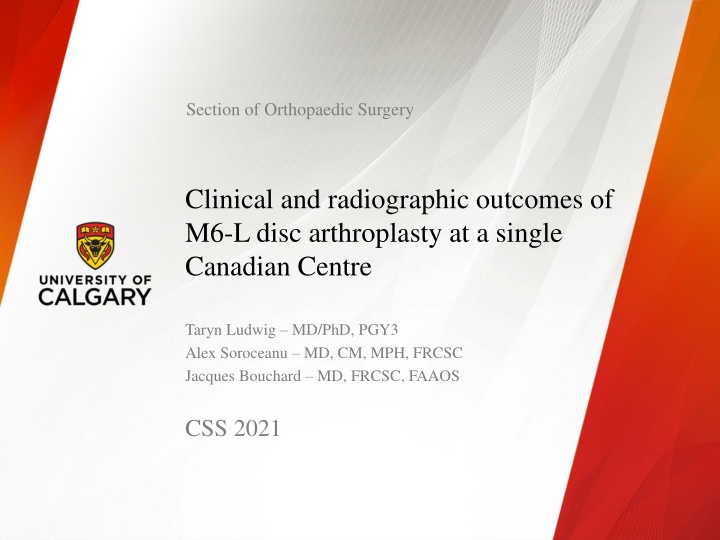
Clinical and Radiographic Outcomes of M6-L Disc Arthroplasty Study
"Explore clinical and radiographic outcomes of M6-L disc arthroplasty procedures at a Canadian center. The study compares the efficacy and safety of various lumbar disc arthroplasty approaches, including single-level, dual-level, and hybrid procedures using the M6-L prosthesis. Findings suggest that LDA achieves comparable results to fusion, with improvements in clinical outcomes over mid- to long-term follow-up periods. Detailed methodology, patient demographics, and statistical analyses are presented to provide insights into the effectiveness of M6-L disc arthroplasty. Disclosure statements and references to related research are also included."
Download Presentation

Please find below an Image/Link to download the presentation.
The content on the website is provided AS IS for your information and personal use only. It may not be sold, licensed, or shared on other websites without obtaining consent from the author. If you encounter any issues during the download, it is possible that the publisher has removed the file from their server.
You are allowed to download the files provided on this website for personal or commercial use, subject to the condition that they are used lawfully. All files are the property of their respective owners.
The content on the website is provided AS IS for your information and personal use only. It may not be sold, licensed, or shared on other websites without obtaining consent from the author.
E N D
Presentation Transcript
Section of Orthopaedic Surgery Clinical and radiographic outcomes of M6-L disc arthroplasty at a single Canadian Centre Taryn Ludwig MD/PhD, PGY3 Alex Soroceanu MD, CM, MPH, FRCSC Jacques Bouchard MD, FRCSC, FAAOS CSS 2021
Objective Canadian and non-industry sponsored outcome data for lumbar disc arthroplasty (LDA) are limited LDA achieves at least similar clinical outcomes and complication rates compared to fusion (1-3) Single level, dual level, and hybrid LDA/fusion procedures provide improvement in clinical outcomes at mid- to long-term timepoints (4-6) The M6-L is a second-generation non-articulating LDA prosthesis M6-L is used at our centre under Health Canada exemption The objective of this study is to provide clinical and radiographic outcome data for patients undergoing single level, dual level, or hybrid fusion+LDA procedures with the M6-L prosthesis http://www.spinalkinetics.com/m6-l/m6-l-overview/ 1. Cui et al. J Orthop Surg Res. 2018;6:1 12, 2. Zigler J et al. Global Spine J. 2018;8(4):413 23. 3. Formica M et al. J Orthop Traumatol. 2017;18(3):197 215. 4. Formica C et al. Eur Spine J [Internet]. 2019. https://doi.org/10.1007/s00586-019-06100-3. 5. Scott-Young M et al. Spine (Phila Pa 1976). 2020;45(1):18 25. 6. Scott-Young M et al. Spine (Phila Pa 1976). 2017;43(2):75 81.
Methods Retrospective cohort: All patients receiving single level, dual level, or hybrid M6-L procedures by a single surgeon with extensive LDA experience from October 2013 June 2019 CSORN database (not all patients participated): Demographic data: age, BMI Length of stay (LOS) Complications Patient reported outcomes: VAS back, VAS leg, ODI Pre-op, 3 months, 1 year, 2 years, 3+ years post-op Chart review: Complications Radiographic outcomes: assessed at last available imaging Segmental ROM Global lumbar lordosis
Patient Demographics Single level 48 40% 60% 39.2 (5.9) 25.5 (3.1) L3/4: 1 L4/5: 8 L5/S1: 39 34 Dual level 10 60% 40% 36.2 (5.0) 25.5 (1.8) L3-5: 2 L4-S1: 8 Hybrid 40 45% 55% 41.8 (6.2) 26.4 (7.7) L3-5: 2 L3-S1: 1 L4-S1: 37 24 Patients (N) Male Female Age (SD) (p = 0.016) BMI (SD) (p = 0.79) Symptomatic level Number in CSORN Baseline 6 database 3 months 25 (74%) 5 (83%) 17 (71%) 1 year 2 years 3+ years 23 (68%) 13 (38%) 9 (26.4%) 1.5 (0.8) 3 (60%) 1 (17%) 0 1.7 (0.8) 14 (58%) 10 (42%) 5 (21%) 2.8 (3.7) Length of stay, days (SD) (p = 0.06)
Clinical Outcomes Statistical comparisons within groups not appropriate given small sample size For pooled cohort of single, dual, and hybrid procedures: Pre-op 6.9 4.3 43.6 1 year post-op 2.4 1.6 15.9 p-value p < 0.0001 p < 0.0001 p < 0.0001 VAS back pain VAS leg pain ODI VAS back pain by procedure over time:
Radiographic Outcomes No significant differences in lordosis between groups No prosthesis subsidence was observed in this study Single level 46 17.5 Dual level 10 13.0 Hybrid 38 19.8 Patients (N) Mean follow-up in months (range) (0.6 60.2) 60.8 (8.8) (4.2 42.3) 64.7 (10.5) (1.0 58.1) 60.0 (10.3) Lordosis ( ) p = 0.38 ROM ( ) 9.1 (4.1) Upper: 10.1 (4.3) Lower: 7.0 (4.3) 9.1 (5.4)
Complications There were no device related complications observed in this study. Single level 1 1 Dual level Hybrid 2 1 Urinary retention Post sympathectomy symptoms Ileus Retrograde ejaculation Vascular injury Other 1 Peri-operative 1 1 1 (transient) 1 (iliac vein) 1 seroma 1 delirium 20% Total peri-operative complication rate Adjacent segment degeneration Facet arthropathy Other 4.2% 20% 1 1 Post-operative 1 foot drop NYD* 1 DVT 1 end plate fracture 1 pericarditis 10% Total post-operative complication rate Trauma Neurologic symptoms Total re-operation rate 4.2% 2 operation 2 foraminotomy at fused level 5% Re- 4.2% *: neurologically intact until 2 years post-operatively, foot drop occurred after a fall. Unrelated to M6-L prosthesis.
Discussion First study presenting outcomes after treatment with the M6-L LDA prosthesis in a Canadian population Limitations Small population size: Vast referral area = lower follow-up rate due to travel requirement Younger population = lower follow-up rate due to more transient laborers Radiographic outcomes at last follow-up Non-standardized timepoint Significant improvement in clinical outcomes Unable to compare procedures due to population size Mid-term follow-up: longer follow-up needed Continued assessment of clinical outcomes as more patients receive the M6-L prosthesis will help increase the sample size for future studies
Conclusions This study demonstrates that the M6-L lumbar disc arthroplasty prosthesis is safe and effective for treatment of discogenic back pain in this Canadian population Significant improvement in patient reported outcome scores post-operatively Complication rates: 4-20% No serious device related adverse events Questions/feedback? Please get in touch! Taryn Ludwig: teludwig@ucalgary.ca Jacques Bouchard: bouchard@ucalgary.ca
